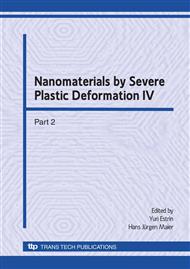p.507
p.513
p.518
p.523
p.528
p.535
p.541
p.547
p.553
Grain Boundary Structure and Deformation Defects in Nanostructured Al–Mg Alloys Processed by High Pressure Torsion
Abstract:
An Al–0.5 Mg alloy and a commercial AA5182 alloy were subjected to high pressure torsion (HPT) to five turns under pressure of 6 GPa at room temperature. The grain boundary structure and deformation defects were investigated after HPT using high-resolution transmission electron microscopy (HRTEM). Low-angle, high-angle, equilibrium and non-equilibrium grain/subgrain boundaries, twin boundaries, full dislocations, dipoles, microtwins and stacking faults were identified by HRTEM. Extrinsic 60° dislocations in the form of dipoles were frequently observed in non-equilibrium grain/subgrain boundaries. In addition subgrain size distributions and dislocation densities were quantified by x-ray line profile analysis. It was observed that the average grain size decreased from about 120 nm to 55 nm as the Mg content increased from 0.5 to 4.1 wt%. Concomitantly the average stored dislocation density increased from 1.7 to 12.8 1014 m-2. Based on the HRTEM investigations and the x-ray line profile analyses, the deformation mechanism associated with the typical grain boundaries and deformation defects in the aluminium alloys were discussed.
Info:
Periodical:
Pages:
528-534
Citation:
Online since:
June 2008
Authors:
Price:
Сopyright:
© 2008 Trans Tech Publications Ltd. All Rights Reserved
Share:
Citation:


